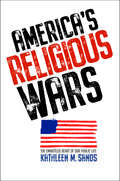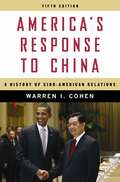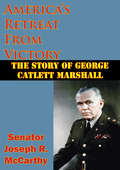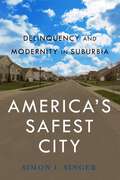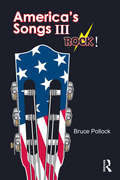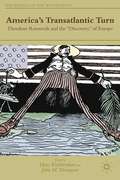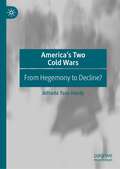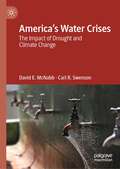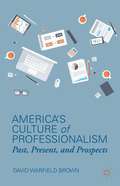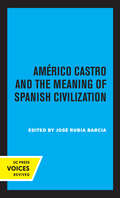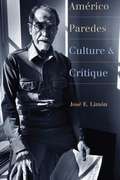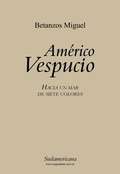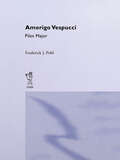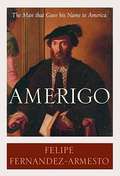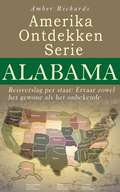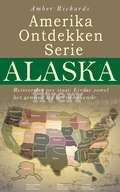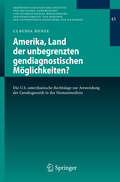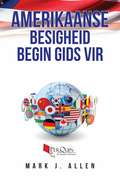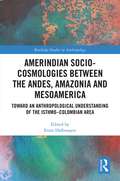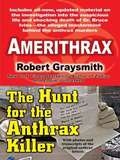- Table View
- List View
America’s Religious Wars: The Embattled Heart of Our Public Life
by Kathleen M. SandsHow American conflicts about religion have always symbolized our foundational political values When Americans fight about “religion,” we are also fighting about our conflicting identities, interests, and commitments. Religion-talk has been a ready vehicle for these conflicts because it is built on enduring contradictions within our core political values. The Constitution treats religion as something to be confined behind a wall, but in public communications, the Framers treated religion as the foundation of the American republic. Ever since, Americans have translated disagreements on many other issues into an endless debate about the role of religion in our public life. Built around a set of compelling narratives—George Washington’s battle with Quaker pacifists; the fight of Mormons and Catholics for equality with Protestants; Teddy Roosevelt’s concept of land versus the Lakota’s concept; the creation-evolution controversy; and the struggle over sexuality—this book shows how religion, throughout American history, has symbolized, but never resolved, our deepest political questions.
America’s Response to China: A History of Sino-American Relations
by Warren I. CohenAmerica's Response to China has long been the standard resource for a succinct, historically grounded assessment of an increasingly complicated relationship. Written by one of America's leading diplomatic historians, this book analyzes the concerns and conceptions that have shaped U.S.-China policy and examines their far-reaching outcomes. <P><P>Warren I. Cohen begins with the mercantile interests of the newly independent American colonies and discusses subsequent events up to the Tiananmen Square massacre and the policies of George H. W. Bush and Bill Clinton. For this fifth edition, Cohen adds a chapter on America in the age of potential Chinese ascendance, envisioning future partnerships and the shrinking global influence of the United States. Trenchant and insightful, America's Response to China is critically important for understanding U.S.-China relations in the twenty-first century.
America’s Retreat From Victory: The Story Of George Catlett Marshall
by Senator Joseph R. McCarthyBy 1950 General George C. Marshall was seen by the American public an outstanding hero of their time; his masterful direction as chief of the US Army Staff during World War Two has set him up as an almost unassailable public figure. However hardline senator Joseph McCarthy took no prisoners, and in this well researched account, he takes a furious swipe at the General. Although future generations were only to know McCarthy for his ill-advised witchhunts later in his career, this book still stands as a damning indictment of the conduct of the American War Policy during the Second World War and particularly General Marshall.
America’s Safest City: Delinquency and Modernity in Suburbia (New Perspectives in Crime, Deviance, and Law #3)
by Simon I. SingerWinner of the American Society of Criminology 2015 Michael J. Hindelang Book Award for the Most Outstanding Contribution to Research in CriminologySince the mid-1990s, the fast-growing suburb of Amherst, NY has been voted by numerous publications as one of the safest places to live in America. Yet, like many of America’s seemingly idyllic suburbs, Amherst is by no means without crime—especially when it comes to adolescents. In America’s Safest City, noted juvenile justice scholar Simon I. Singer uses the types of delinquency seen in Amherst as a case study illuminating the roots of juvenile offending and deviance in modern society. If we are to understand delinquency, Singer argues, we must understand it not just in impoverished areas, but in affluent ones as well.Drawing on ethnographic work, interviews with troubled youth, parents and service providers, and extensive surveys of teenage residents in Amherst, the book illustrates how a suburban environment is able to provide its youth with opportunities to avoid frequent delinquencies. Singer compares the most delinquent teens he surveys with the least delinquent, analyzing the circumstances that did or did not lead them to deviance and the ways in which they confront their personal difficulties, societal discontents, and serious troubles. Adolescents, parents, teachers, coaches and officials, he concludes, are able in this suburban setting to recognize teens’ need for ongoing sources of trust, empathy, and identity in a multitude of social settings, allowing them to become what Singer terms ‘relationally modern’ individuals better equipped to deal with the trials and tribulations of modern life. A unique and comprehensive study, America’s Safest City is a major new addition to scholarship on juveniles and crime in America.Crime, Law and Social Change's special issue on America's Safest City
America’s Songs III: Rock!
by Bruce PollockAmerica’s Songs III: Rock! picks up in 1953 where America’s Songs II left off, describing the artistic and cultural impact of the rock ’n’ roll era on America’s songs and songwriters, recording artists and bands, music publishers and record labels, and the all-important consuming audience. The Introduction presents the background story, discussing the 1945-1952 period and focusing on the key songs from the genres of jump blues, rhythm ’n’ blues, country music, bluegrass, and folk that combined to form rock ‘n’ roll. From there, the author selects a handful of songs from each subsequent year, up through 2015, listed chronologically and organized by decade. As with its two preceding companions, America’s Songs III highlights the most important songs of each year with separate entries. More than 300 songs are analyzed in terms of importance—both musically and historically—and weighted by how they defined an era, an artist, a genre, or an underground movement. Written by known rock historian and former ASCAP award winner Bruce Pollock, America’s Songs III: Rock! relays the stories behind America’s musical history.
America’s Struggle against Poverty in the Twentieth Century: Enlarged Edition
by James T. PattersonThis new edition of Patterson's widely used book carries the story of battles over poverty and social welfare through what the author calls the "amazing 1990s," those years of extraordinary performance of the economy. He explores a range of issues arising from the economic phenomenon--increasing inequality and demands for use of an improved poverty definition. He focuses the story on the impact of the highly controversial welfare reform of 1996, passed by a Republican Congress and signed by a Democratic President Clinton, despite the laments of anguished liberals.
America’s Transatlantic Turn
by John M. Thompson Hans KrabbendamThis collection uses Theodore Roosevelt to form a fresh approach to the history of US and European relations, arguing that the best place to look for the origins of the modern transatlantic relationship is in Roosevelt's life and career.
America’s Two Cold Wars: From Hegemony to Decline?
by Alfredo Toro HardyThis book focuses on ascertaining what distinguishes the Cold War that the U.S. sustained with the USSR from the one now emerging with China. By comparing their characteristics, it elaborates on how well prepared the US is to undertake this fresh challenge. In doing so, the book analyses six fundamental differences between both cold wars; ideology, alliances, strategic consistency, military, economics, and containment. While the configuration of factors benefited the US during its first Cold War, they now point in the opposite direction. While the first Cold War was instrumental in projecting the US to the pinnacle, the second can only accelerate its dwindling.
America’s Water Crises: The Impact of Drought and Climate Change
by David E. McNabb Carl R. SwensonThis book is focused exclusively on water problems in the 48 U.S. states. The authors provide an accessible overview of the work of many federal, state and academic researchers and water system administrators whose investigations have focused on the state of water and the water crisis now accelerating in the United States. David McNabb and Carl Swenson seek to bring to a wider audience some of the current research findings and data on the perilous state of the United States’ surface and groundwater resources during this time of climate change and the extreme drought taking place in many sections of the nation. Descriptions of the water resource systems are based on research and the subsequent findings published by water scientists in the United States Geological Survey, the Environmental Protection Agency, the U.S. Corps of Engineers and water related agencies of the Departments of Agriculture and of the Interior and state and local water management agencies.
America�s Culture of Professionalism
by David Warfield BrownAmerica's Culture of Professionalism proves an emerging culture of interdependence is possible if and when enough professionals and laypersons refashion their roles and relationships having both something to contribute and something to learn from each other.
Americhem: The Gaylord Division (A-1)
by David A. GarvinThe Gaylord Division of Americhem, a large chemical company, is in the midst of the first use of a new zero-base budgeting system. The general manager of the division leading the process is experiencing disagreement and conflict among the members of the senior management team. This case describes a difficult meeting. A rewritten version of an earlier case.
Americhem: The Gaylord Division (B-1)
by David A. GarvinSupplements the (A) case, 314011. A rewritten version of an earlier supplement.
Americo Castro and the Meaning of Spanish Civilization
by José Rubia BarciaThis title is part of UC Press's Voices Revived program, which commemorates University of California Press’s mission to seek out and cultivate the brightest minds and give them voice, reach, and impact. Drawing on a backlist dating to 1893, Voices Revived makes high-quality, peer-reviewed scholarship accessible once again using print-on-demand technology. This title was originally published in 1976.
Americo Paredes: Culture and Critique
by Jose E. LimonSeveral biographies of Américo Paredes have been published over the last decade, yet they generally overlook the paradoxical nature of his life's work. Embarking on an in-depth, critical exploration of the significant body of work produced by Paredes, José E. Limón (one of Paredes's students and now himself one of the world's leading scholars in Mexican American studies) puts the spotlight on Paredes as a scholar/citizen who bridged multiple arenas of Mexican American cultural life during a time of intense social change and cultural renaissance. Serving as a counterpoint to hagiographic commentaries, Américo Paredes challenges and corrects prevailing readings by contemporary critics of Paredes's Asian period and of such works as the novel George Washington Gómez, illuminating new facets in Paredes's role as a folklorist and public intellectual. Limón also explores how the field of cultural studies has drifted away from folklore, or "the poetics of everyday life," while he examines the traits of Mexican American expressive culture. He also investigates the scholarly paradigm of ethnography itself, a stimulating inquiry that enhances readings of Paredes's best-known study, "With His Pistol in His Hand," and other works. Underscoring Paredes's place in folklore and Mexican American literary production, the book questions the shifting reception of Paredes throughout his academic career, ultimately providing a deep hermeneutics of widely varied work. Offering new conceptions, interpretations, and perspectives, Américo Paredes gives this pivotal literary figure and his legacy the critical analysis they deserve.
Americo Vespucio
by Miguel BetanzosBiografía de Americo Vespucio Américo Vespucio ha pasado a la historia sobre todo como el personajeque dio nombre a un continente, pero su propia trayectoria personal espoco conocida. Denostado en su momento entre exploradores y científicos,al tiempo que recibía honores oficiales, sus inicios como diplomático alas órdenes de los Médici le pusieron en contacto con aventureros que lellevaron a participar en una expedición al Nuevo Mundo financiada por laCorona española, y aún habría otro viaje bajo pabellón portugués,siempre con el propósito de conocer a fondo el nuevo continente yofrecer a la comunidad científica y al mundo noticia fiel de lo que vioy averiguó acerca de la geografía, la meteorología, la fauna y la florarecién descubierta.
Americomania and the French Revolution Debate in Britain, 1789-1802
by Wil VerhoevenThis book explores the evolution of British identity and participatory politics in the 1790s. Wil Verhoeven argues that in the course of the French Revolution debate in Britain, the idea of America came to represent for the British people the choice between two diametrically opposed models of social justice and political participation. Yet the American Revolution controversy in the 1790s was by no means an isolated phenomenon. The controversy began with the American crisis debate of the 1760s and 1770s, which overlapped with a wider Enlightenment debate about transatlantic utopianism. All of these debates were based in the material world on the availability of vast quantities of cheap American land. Verhoeven investigates the relation that existed throughout the eighteenth century between American soil and the discourse of transatlantic utopianism: between America as a physical, geographical space, and America as a utopian/dystopian idea-image.
Amerigo Vespucci Pilot Cb: Amerigo Vespucci Pilot Ma
by Frederick Julius PohlFirst published in 1967
Amerigo: The Man Who Gave His Name to America
by Felipe Fernández-ArmestoIn this biography of the man for whom America is named, historian Fernandez-Armesto delves into life and explorations of Amerigo Vespucci. Vespucci was a prominent self-promoter in the 15th century and Fernandez-Armesto successfully narrates his achievements in this book which in 2007 marked the 500th anniversary of the naming of America.
Amerika Ontdekken Serie Alabama - Reisverslag per staat Ervaar zowel het gewone als het onbekende
by Amber Richards Luc WynWanneer plaatselijke bewoners een overzicht willen van wat er zoal gebeurt in hun eigen staat ... keren ze zich naar Amber Richards’ “Amerika verkennen” serie! Daarom beginnen reizigers nu ook in te pikken op deze waardevolle serie. Meer dan alleen maar reisgidsen, zijn deze staat-per-staat edities een deur naar de lokale bewoners, de evenementen, de goederen, het eten, zichten, geluiden en personages die je MOET ervaren als je het recht wil om te zeggen:”Ik ben daar geweest!” Boekbeschrijving Het is niet een typische reisgids in de zin dat de aandacht niet ligt op waar je kan eten en waar je kan verblijven, maar eerder op waar je heen kan gaan en wat je kan ervaren om een authentiek beeld te krijgen van Alabama. In deze editie werkt Amber samen met een plaatselijke bewoner van Alabama om het fijne te weten van de echte wilde grensstreek van Amerika. Van welbekende attrakties en de geschiedenis erachter, tot de onbekende, minder bereisde ervaringen, levert juffrouw Richards U het echte Alabama binnen handbereik! Download uw kopij nu.
Amerika Ontdekken Serie Alaska Reisverslag per staat – Ervaar zowel het gewone als het onbekende
by Amber Richards Luc WynWanneer plaatselijke bewoners een overzicht willen van wat er zoal gebeurt in hun eigen staat ... keren ze zich naar Amber Richards’ “Amerika verkennen” serie! Daarom beginnen reizigers nu ook in te pikken op deze waardevolle serie. Meer dan alleen maar reisgidsen, zijn deze staat-per-staat edities een deur naar de lokale bewoners, de evenementen, de goederen, het eten, zichten, geluiden en personages die je MOET ervaren als je het recht wil om te zeggen:”Ik ben daar geweest!” Het is niet een typische reisgids in de zin dat de aandacht niet ligt op waar je kan eten en waar je kan verblijven, maar eerder op waar je heen kan gaan en wat je kan ervaren om een authentiek beeld te krijgen van Alaska. In deze editie werkt Amber samen met een plaatselijke Alaskaan om het fijne te weten van de echte wilde grensstreek van Amerika. Van welbekende attrakties en de geschiedenis erachter, tot de onbekende minder bereisde ervaringen, levert juffrouw Richards U het echte Alaska binnen handbereik! Een tip van de sluier: Neem beerafweermiddel mee, uw favoriete dansschoenen, watervaste lucifers, een stevig biefstuk mes, en uw favoriete bierkroes. Tot ziens aan de wilde kant. Download uw kopij nu.
Amerika, Land der unbegrenzten gendiagnostischen Möglichkeiten?: Die U.S.-amerikanische Rechtslage zur Anwendung der Gendiagnostik in der Humanmedizin (Veröffentlichungen des Instituts für Deutsches, Europäisches und Internationales Medizinrecht, Gesundheitsrecht und Bioethik der Universitäten Heidelberg und Mannheim #45)
by Claudia HenzeDas Buch gewährt einen umfassenden Überblick über den Status quo der U. S. -amerikanischen Rechtslage zu Humangentests, die in der Medizin zum Einsatz kommen. Die U. S. A. nehmen auf dem Gebiet der Humangenetik und in der Übertragung der erzielten Forschungsergebnisse in die medizinische Praxis international eine Spitzenposition ein. Ausdruck dieser überragenden Stellung der Vereinigten Staaten ist, dass die dort entwickelten Erbguttests und Verfahren weltweit genutzt werden. Dies gilt neben Verbrauchergentests von U. S. -Anbietern auch für klinische Gentests, die Mediziner außerhalb der U. S. A. bei ihren Patienten veranlassen und anschließend zur Auswertung an ein Labor des U. S. -Testherstellers schicken. Die Autorin untersucht im Hinblick auf diese internationale Dimension insbesondere, inwieweit die Qualitätssicherung humangendiagnostischer Tests, der Schutz vor genetischer Diskriminierung sowie die Vertraulichkeit genetischer Gesundheitsdaten in den Vereinigten Staaten gewährleistet sind.
Amerikaanse besigheid begin gids vir locksmith
by Mark J. AllenDie Amerikaanse besigheid module is gerig aan al die ambisie volle en hardwerkende individue wat strewe na ‘n voorspoedige manier van lewe
Amerindian Socio-Cosmologies between the Andes, Amazonia and Mesoamerica: Toward an Anthropological Understanding of the Isthmo-Colombian Area (Routledge Studies in Anthropology)
by Ernst HalbmayerThis book offers a new anthropological understanding of the socio-cosmological and ontological characteristics of the Isthmo–Colombian Area, beyond established theories for Amazonia, the Andes and Mesoamerica. It focuses on a core region that has been largely neglected by comparative anthropology in recent decades. Centering on relations between Chibchan groups and their neighbors, the contributions consider prevailing socio-cosmological principles and their relationship to Amazonian animism and Mesoamerican and Andean analogism. Classical notions of area homogeneity are reconsidered and the book formulates an overarching proposal for how to make sense of the heterogeneity of the region’s indigenous groups. Drawing on original fieldwork and comparative analysis, the volume provides a valuable anthropological addition to archaeological and linguistic knowledge of the Isthmo・Colombian Area.
Amerithrax
by Robert GraysmithThe first book on the unsolved case that terrorized a nation in the aftermath of September 11th is now updated with new material, including photos and transcripts of original anthrax letters that were received by NBC Nightly News anchor Tom Brokaw and Senate Majority Leader Tom Daschle.
Ameritopia
by Mark R. LevinAN INTELLECTUALLY BRACING NEW VOLUME ON AMERICA'S TRANSFORMATION AND THE CLASH BETWEEN CONSTITUTIONALISM AND UTOPIANISM--FROM THE AUTHOR OF THE #1 NEW YORK TIMES BESTSELLER LIBERTY & TYRANNY , MARK R. LEVIN Hailed by Rush Limbaugh as "the most compelling defense of freedom for our time," and "the necessary book of the Obama era" by The American Spectator, Mark R. Levin's Liberty and Tyranny made the most persuasive case for conservatism and against statism in a generation. In this most crucial time, this leading conservative thinker explores the psychology, motivations, and history of the utopian movement, its architects, and its modern-day disciples--and how the individual and American society are being devoured by it. Levin asks, what is this utopian force that both allures a free people and destroys them? Levin digs deep into the past and draws astoundingly relevant parallels to contemporary America from Plato's Republic Thomas More's Utopia Thomas Hobbes's Leviathan Karl Marx's Communist Manifesto . . . as well as from the critical works of John Locke, Charles Montesquieu, Alexis de Tocqueville, and other philosophical pioneers who brilliantly diagnosed the nature of man and government. As Levin meticulously pursues his subject, the reader joins him in an enlightening and compelling journey. And in the end, Levin's message is clear: the American republic is in great peril. The people must now choose between utopianism or liberty. President Ronald Reagan warned, "freedom is never more than one generation away from extinction." Levin agrees, and with Ameritopia, delivers another modern political classic, an indispensable guide for America in our time and in the future.
